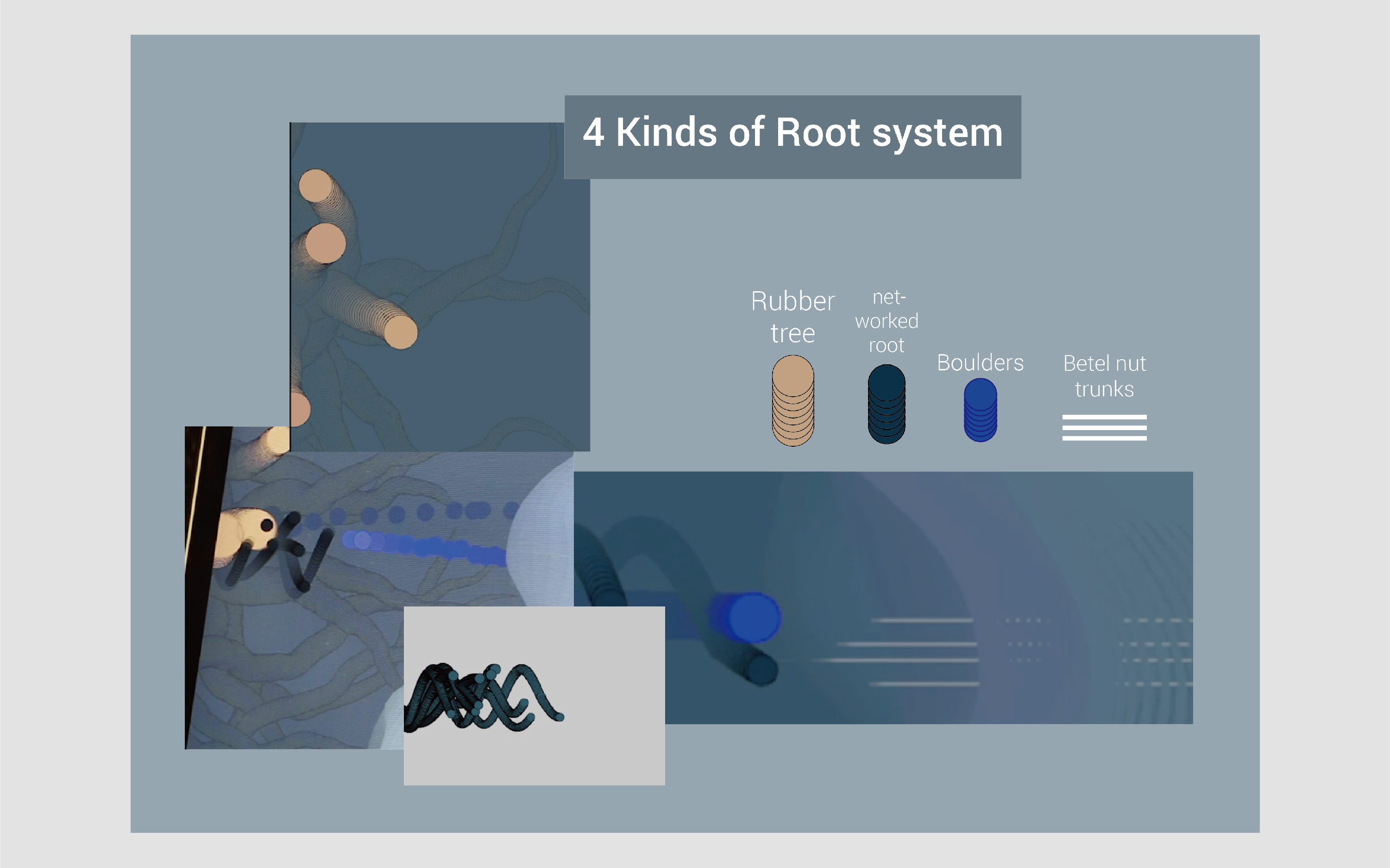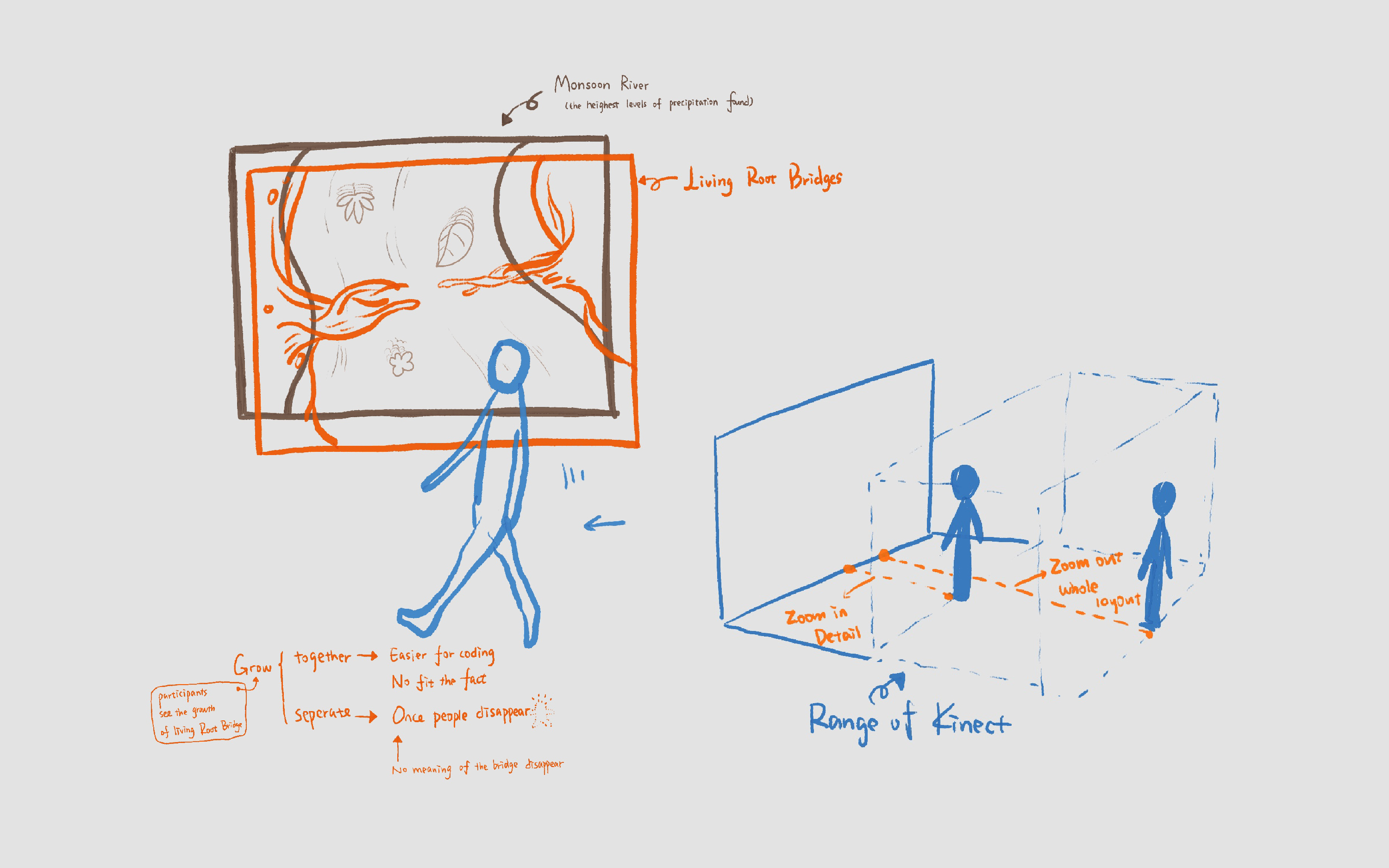Living Root Bridge
This is a Kinect based project talking about the relationship between nature and humans. Facing a multitude of environmental issues like sea-level rise, how could people live in harmony with environments?
produced by: Mengdi Li
Introduction
Have you ever imagined that the infrastructure of architecture will increase in strength and scale over time? Compared with the erosion of traditional bridges, people from the Khasis tribe in northern India guided growing trees across the riverine corridors. The root system of trees grows along the river corridor to withstand the force of the monsoonal rains with the highest levels of precipitation found on earth.
The flourish of tourism industries not only brings wealth but also pushes the bridges on the verge of possible collapse due to overuse. Facing a multitude of environmental issues, how could people live in harmony with environments? What is the relationship between natural and human being?
Concept and background research
The weather during lockdown is more attractive than usual. When I was trapped in my small house, I fell into the fantasy that if the wall could breathe and live with me. And then Lo-TEK Design by Radical Indigenism (Julia Watson, 2020) gave the possible answer, which is this living architecture.
Living Root Bridge is a real bridge in northern India, it’s a type of simple suspension bridge formed of living plant roots by tree shaping. Compared with the erosion of traditional bridges, the roots in this bridge can naturally grow thick and strengthen and it will naturally self-renew and self-strengthen. Under ideal conditions, a living root bridge can last for many hundreds of years.
The living root bridges provide convenience and wealth for people. However, the flourish of tourism industries not only bring wealth to local people but also push the bridges on the verge of possible collapse due to overuse[1]. It’s hard to notice that humans are rushing the pace of the natural process because they have enough water, air, food and so on. The natural world is providing resources and people are depleting them. Facing a multitude of environmental issues, how could people live in harmony with environments? What is the relationship between natural and human being?
Technology and interaction
What if the world is full of water? Living Root Bridge is built in Cherrapunji area, which is the wettest place on earth. “Travel between villages is cut off by floodwaters that transform the landscape from a thick canopy to isolated forest islands.” And these are the only bridges that can withstand the flow of the monsoonal rivers. That is why the entire image is submerged underwater.
Kinect is used to capture the audience's shape and shown on the projector. Raspberry pi shows the demo video. The position of the blue ellipse is calculated by finding the average x and average y of people. Based on the participants' position, there will be two situations shown on the screen. For normal showing without human, a virtual river will be running in the middle and a living tree root is growing on each side of the screen. When the audience shows up, there will be four kinds of the root which represent different stages of the growth of the Living Root Bridge structure system:
- The yellow tree roots are the original Ficus elastica tree growing on each side of the river. Local people climb the tree and use their weight to curve the pliable rubber tree trunks to guide the growth. This is the basic structure of this living root bridge.
- Betel nut trunks are cut down and hollowed out to form a root-guidance system that crosses a stream, which is the white rectangles on the screen.
- Blue ellipse represents the boulders on the bridge which were carried to the bridge by the locals.
- And the black root is a young networked system of roots tied or twisted together to solid the bridge. The number of growing black roots depends on the position of the audience. If people stand on the left side, there will be more roots growing. If people leave far away from the group of black roots, the black root system will stop growing.
Participants could join and guide part of building this bridge, but there are things they cannot control. Audiences’ trace will remain on the screen when they leave a certain area. However, the best way to protect nature is by doing nothing, that is why the river and yellow roots (original Ficus trees) on each side could remove the traces left by a human by looping their natural trace over and over again. Tree roots grow quite slow. In northern India, At least three generations of people were helping to grow this tree to help them cross the huge river. What I want to do is speed up the growing and show the biodiverse sustainable agrarian system to more people.
Visual Inspiration
When I was finding a visual way to demonstrate root, Praying Hands, a pen-and-ink drawing by the German painter Albrecht Dürer inspired me. On this painting, he used repeating curly lines over and over again to make the image look more three-dimensional. And for my homework from last semester, I was using lines to imitate the human gesture when they are playing different musical instruments, so this time I keep using the ellipse line to draw the vivid roots.
Future development and Self-evaluation
I was fancy with the complicity and sustainability of this bridge, and I am satisfied the positive comments and participants could feel the magic of nature. However, when I observe the audience's reaction on the side, I found that the simplified line pattern image is still difficult to understand, and the distinction between each root system by different colours does not look obvious enough. This is the visual part I need to improve in the future. For this exhibition, I was using both computer and raspberry pi to show the project. However, due to the limit of sd card, I failed with running and capturing data from Kinect on Linux system, this is a direction I need to learn and fix.
The traces left by the audience can remain on the screen, but if too many people are shown on the screen, the tree could be damaged. However due to COVID situation, the capacity of the room in this exhibition is three, which means only three people could stay in that room, unfortunately, this is the part I cannot achieve this year. After the bridge is completed, I saw people were waiting for more results. It is best to show the prosperity of people living in harmony with nature. For further development, living root bridge could be an element of a game talking about human and nature or an interactive animation to demonstrate more narrative content.
References
- 1. Watson, J., n.d. Lo-Tek Design By Radical Indigenism.
- How to build a resilient future using ancient wisdom, Julia Watson, TED 2020
https://www.ted.com/talks/julia_watson_how_to_build_a_resilient_future_using_ancient_wisdom?utm_campaign=tedspread&utm_medium=referral&utm_source=tedcomshare - The Butterfly Effect: Interconnectedness of Humans and the Natural World | Cain Landry | TEDxUMaine
https://www.youtube.com/watch?v=flVYligSDPQ
Code References
- https://www.openprocessing.org/sketch/2920
- https://www.openprocessing.org/sketch/679412
- https://www.jaredwolff.com/cross-compiling-on-mac-osx-for-raspberry-pi/#!
- https://desertbot.io/blog/headless-raspberry-pi-4-ssh-wifi-setup


































































